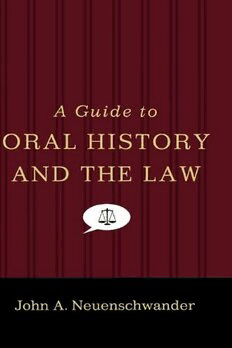
A Guide to Oral History and the Law PDF
Preview A Guide to Oral History and the Law
A Guide to Oral History and the Law A Guide to Oral History and the Law Second Edition JOHN A. NEUENSCHWANDER 1 1 Oxford University Press is a department of the University of Oxford. It furthers the University’s objective of excellence in research, scholarship, and education by publishing worldwide. Oxford New York Auckland Cape Town Dar es Salaam Hong Kong Karachi Kuala Lumpur Madrid Melbourne Mexico City Nairobi New Delhi Shanghai Taipei Toronto With offices in Argentina Austria Brazil Chile Czech Republic France Greece Guatemala Hungary Italy Japan Poland Portugal Singapore South Korea Switzerland Thailand Turkey Ukraine Vietnam Oxford is a registered trademark of Oxford University Press in the UK and certain other countries. Published in the United States of America by Oxford University Press 198 Madison Avenue, New York, NY 10016 © 2009, 2014 by Oral History Association All rights reserved. No part of this publication may be reproduced, stored in a retrieval system, or transmitted, in any form or by any means, without the prior permission in writing of Oxford University Press, or as expressly permitted by law, by license, or under terms agreed with the appropriate reproduction rights organization. Inquiries concerning reproduction outside the scope of the above should be sent to the Rights Department, Oxford University Press, at the address above. You must not circulate this work in any other form and you must impose this same condition on any acquirer. Library of Congress Cataloging-in-Publication Data Neuenschwander, John A., author. A guide to oral history and the law / John A. Neuenschwander.—Second edition. pages cm Includes bibliographical references and index. ISBN 978–0–19–934251–8 (pbk. : alk. paper)—ISBN 978–0–19–020987–2 (hardcover : alk. paper) 1. Historians—United States--Handbooks, manuals, etc. 2. Oral history—United States. 3. Copyright—United States. 4. Contracts— United States. 5. Freedom of information—United States. I. Oral History Association. II. Title. KF390.O7N48 2014 344.73'09—dc23 2014030482 9 8 7 6 5 4 3 2 1 Printed in the United States of America on acid-free paper For Lucy Contents Preface xiii A Note on Legal Terms xiv The Use of State Cases xiv The Use of Federal Cases xv Prevention Is the Key xvi Acknowledgments xvii 1 A CASE STUDY 1 2 LEGAL RELEASE AGREEMENTS 3 Drafting Legal Release Agreements 4 Deed of Gift Agreements 5 Contractual Agreements 5 Prefatory Language 6 Future Use Clauses 6 Transfer of Copyright 9 Transfer of Copyright by Nonexclusive License 9 Restricting, Sealing, and Masking Identity 10 Exculpatory and Indemnity Clauses 12 Warranty Clauses 14 Right of Publicity Clauses 15 Legal Release Agreements for Interviewers 15 IRB Modified Agreements 16 Legal Release Agreements for K–12 Projects 17 Explaining Legal Release Agreements 18 Conclusion 19 3 COMPELLED RELEASE OF INTERVIEWS: SUBPOENAS AND FOIA REQUESTS 20 Oral History as Evidence 20 Oral History and Discovery in Civil Cases 21 viii | C ONTENTS Oral History and Discovery in Criminal Matters 23 An Arson Investigation 24 A Criminal Damage Investigation 24 The Boston College Case 25 Impact of the Boston College Case on Oral History? 27 Is There an Archival Privilege? 28 Informing Interviewees That Restrictions Are Not Absolutes 30 Certificates of Confidentiality 31 Admissibility by Statute 32 Freedom of Information Requests 33 Conclusion 34 4 DEFAMATION 35 Republishers Beware 36 The Elements of Defamation 39 The Dead Cannot Be Defamed 39 Statute of Limitations 40 Organizations Also Have Reputations 41 Public Figures Bear a Heavier Burden 41 Negligence versus Actual Malice 42 Limited-Purpose Public Figures 44 Once a Public Figure Always a Public Figure 44 Pure Opinion Is Not Defamatory, But 45 The Major Categories of Defamation 47 Professional Competency: A Special Concern 47 Suggestions for Avoiding Defamation Lawsuits 49 5 PRIVACY ISSUES: THE STEALTH TORTS 51 False Light 52 False Light versus Defamation 52 Common False Light Claims 53 Docudramas and Photographs 54 Possible Links to Oral History 55 Public Disclosure of Private Facts 55 Disclosure of Private Facts in Public Records 57 Passage of Time and Public Figures 58 Possible Links to Oral History 59 CONTENTS | ix Right of Publicity 60 Possible Links to Oral History 61 Do the Dead Have a Right to Privacy? 61 Conclusion 61 6 COPYRIGHT 63 Copyright in Nonfiction Works 64 Copyright Protection of Oral History: A Case Study 64 Using Nonfiction to Create Fiction 65 Ownership 66 Joint Works 66 Works-Made-for-Hire 69 The Six Exclusive Rights of Copyright 71 Length of Copyright Protection 72 Licenses and Transfers 73 Fair Use of Interviews? 73 Suggestions for Analyzing Potential Infringement 78 Pre-Lawsuit Responses to Possible Infringement 79 To Sue or Not to Sue? 80 A Remedy for Infringement in Cyberspace 81 Registration Status Is Crucial 81 Selective Registration 82 The Orphan Interview Problem 83 Resources of the U.S. Copyright Office 87 Copyright and the Federal Government 87 Copyright Protection Elsewhere in the World 88 How to Dispense with Copyright 89 7 ORAL HISTORY AND THE INTERNET 91 Legal and Ethical Authority to Upload 91 Copyright and the Internet 93 Protecting Copyright Online 96 Click-Wrap Agreement Web Sites 96 Notice Only Web Sites 98 Free Access Web Sites 98
